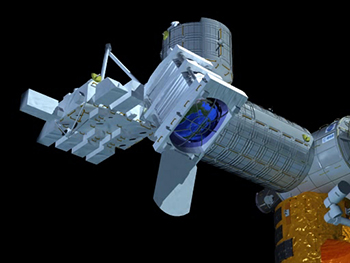
MILWAUKEE—Scientists from five U.S. institutions, including the University of Wisconsin-Milwaukee (UWM), are gearing up for a landmark study of ultra-high-energy cosmic rays – the world’s rarest and most energetic subatomic particles. It is the first time the particles will be recorded from space as they collide with the Earth’s atmosphere.
These cosmic rays carry far more energy than scientists can produce on Earth with a particle accelerator, but how they acquire their extreme energy is a mystery, says Luis Anchordoqui, UWM associate professor of physics.
Discovering the sources of the particles’ acceleration could hold information to high-energy astrophysics and the origins of the universe. The project also could reveal clues about “exotic physics,” such as supersymmetry and string theory.
With a grant from the National Aeronautics and Space Administration (NASA), the six teams will accomplish advance work necessary to launch a telescope mounted to the Japanese Experiment Module (JEM) on the International Space Station (ISS).
That launch is scheduled for 2017 and represents the largest collaboration on the ISS, involving the U.S. and 12 other countries. In addition to UWM, the U.S. team, led by the University of Chicago, includes the Colorado School of Mines, Marshall Space Flight Center (MSFC), Vanderbilt University and the University of Alabama-Huntsville.
The goal of the international mission, called the Extreme Universe Space Observatory (JEM-EUSO), is to use the telescope to scan the night skies around Earth from space and record the luminous “tracks” left when these rare particles collide with the Earth’s atmosphere.
Currently, cosmic ray detection efforts are limited to Earth-bound observatories, says Anchordoqui, who also is a member of an international team studying cosmic rays from the Pierre Auger Observatory in Argentina.
UWM’s role is to coordinate development of the common software framework that all the collaborators will use for analysis. NASA funding will allow additions to the LIGO computing center at UWM for that purpose. The software for the mission’s analysis repository will be written by UWM Senior Scientist Thomas Paul.
Air showers
When ultra-high-energy cosmic rays smack the Earth’s atmosphere, they do so with quite a punch. Imagine a baseball traveling the speed of a major-leaguer’s pitch. Now reduce the ball to the size of a single proton, says Anchordoqui.
On impact, these cosmic bullets produces a shower of splintered “secondary” subatomic particles, each with lower levels of energy each time they collide and splinter.
Since the shower emits ultraviolet light, scientists can reconstruct the paths of the particles by working backward.
Particles with the highest energy won’t be easy to find. They occur only once per square kilometer of sky per millennium. In addition, recording by JEM-EUSO will have to be done at night, with little or no moonlight and away from well-lit urban centers.
“With this mission, we can take advantage of the times the module will be over oceans or in the dark,” says Anchordoqui. “You increase your odds by viewing a larger slice of the night sky.”
In the next year, the U.S. team will calibrate and test the equipment by launching it on a stratospheric balloon.
For more, go to the UWM site, www.gravity.phys.uwm.edu/jem-euso/, or the JEM-EUSO site, jemeuso.riken.jp/en/index.html.
###
(CONTACT: Luis Anchordoqui, 414-229-2245 or 617-953-5066, doqui@gravity.phys.uwm.edu)